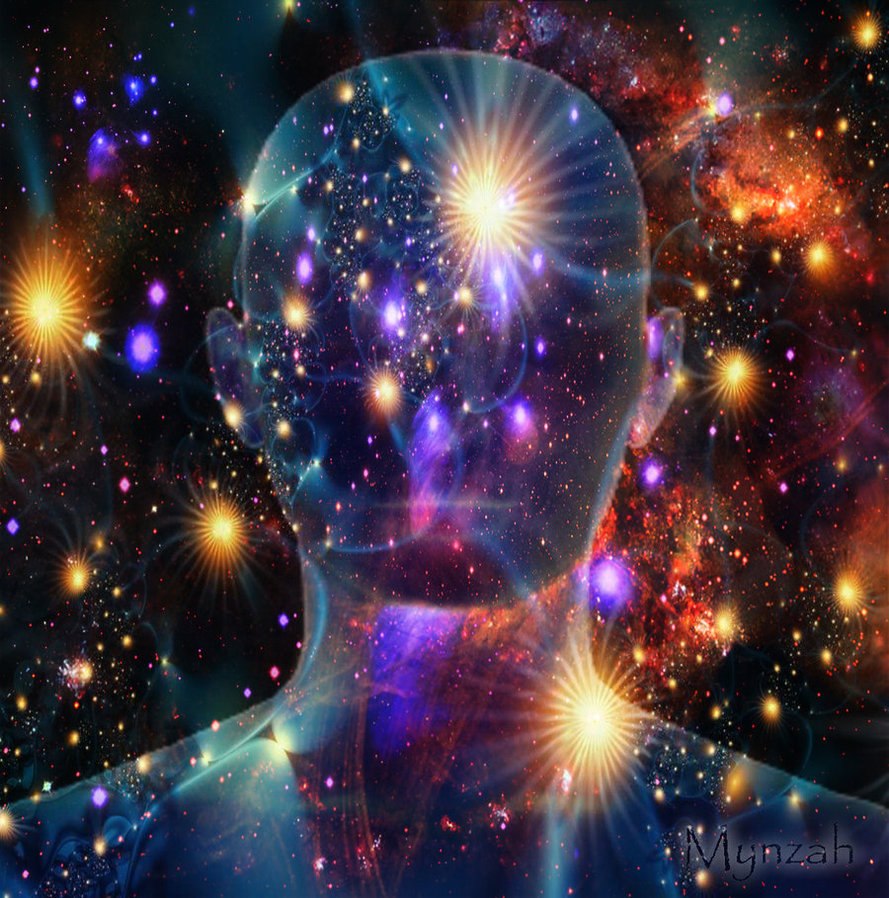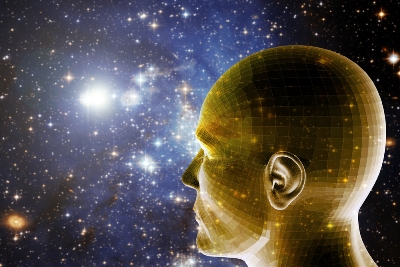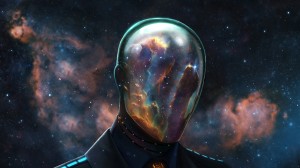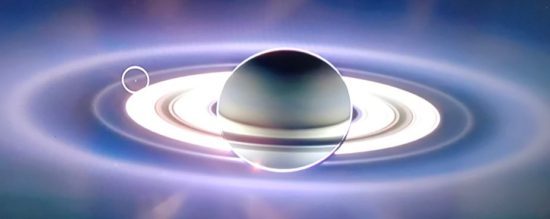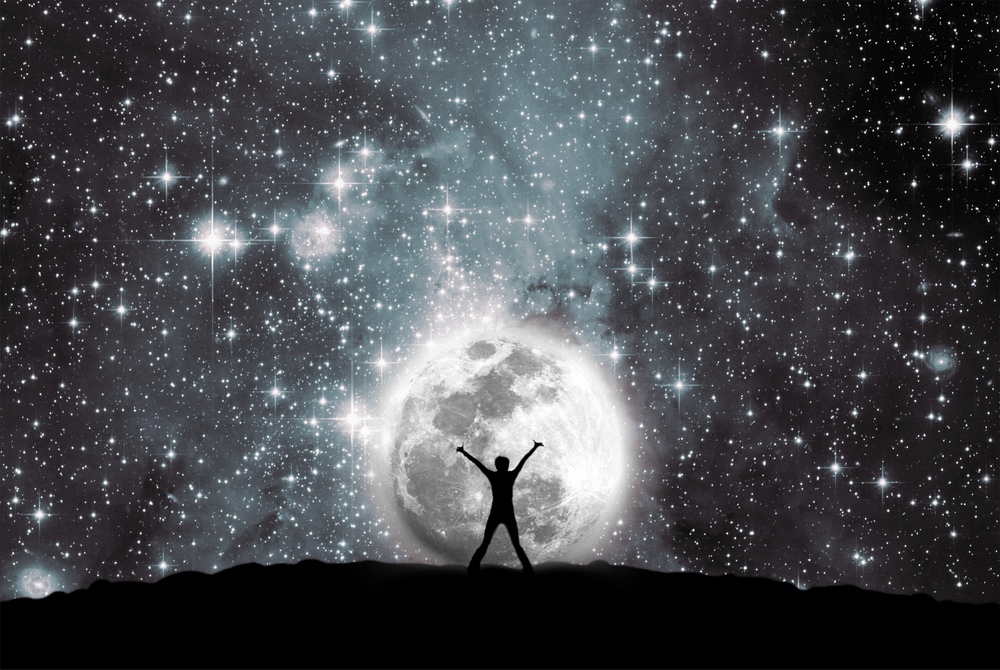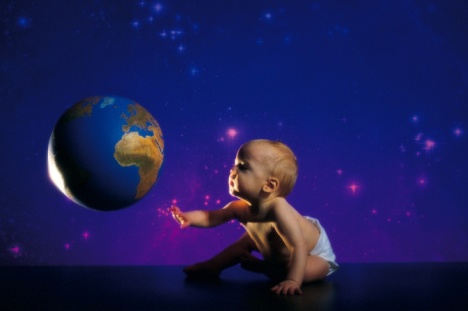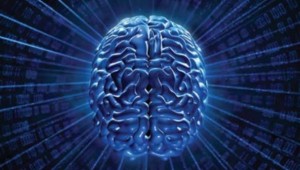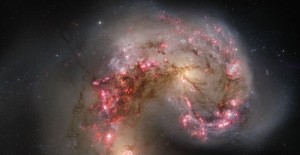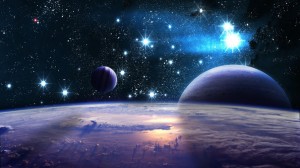Twelve launch-capable space agencies (having as members about thirty countries) are, among other tasks, looking for alien life inside the solar system. They are exploring the four planets closest to the Sun: Mercury, Venus, Earth and Mars, which have three moons among them, and the five outer planets: Jupiter, Saturn, Uranus, Neptune and Pluto, which have one-hundred-and-sixty-three.
With so many moons and planets, the hope is that one of them will harbor life.
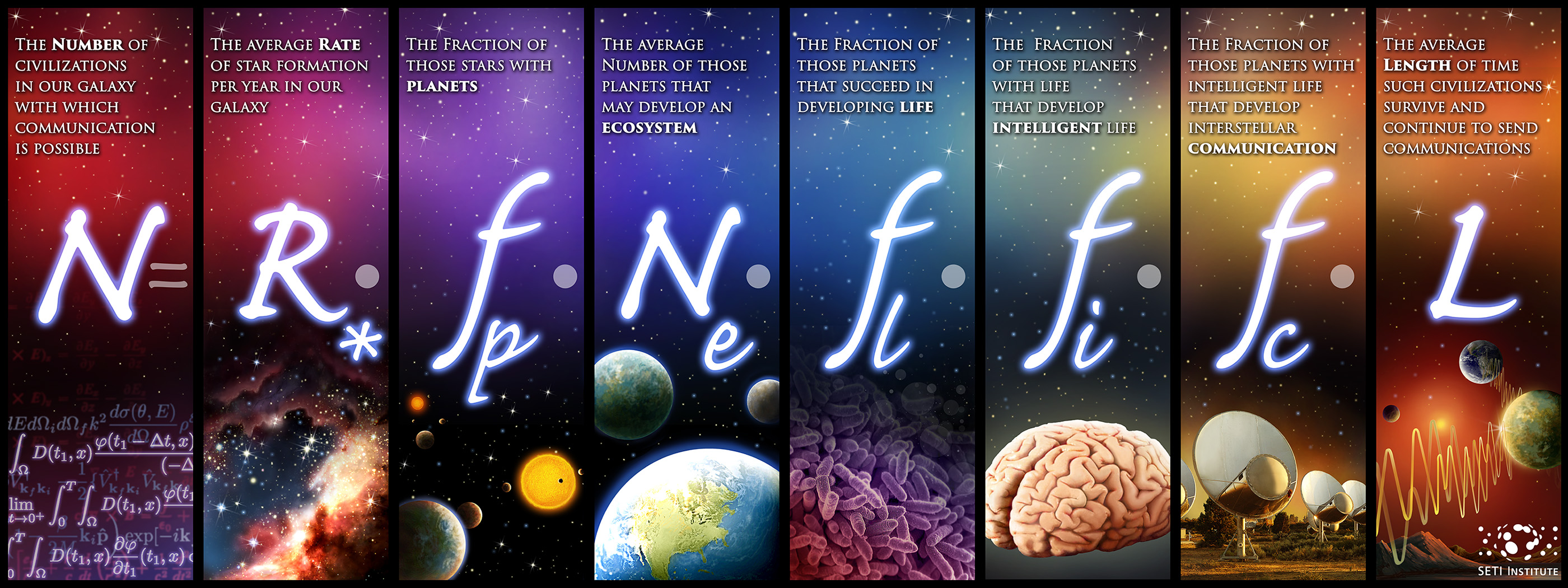
Of the 166 moons and nine planets in the solar system, probes have managed to land on only five: Venus, Mars, Jupiter, Earth’s moon, and Titan (a moon of Saturn).
Just three moons are located in the Goldilocks zone where most scientists believe life has the best chance to take hold. Two orbit Mars at the outer edge of the habitable zone and are probably too cold and irradiated for life. The third moon orbits Earth.

Six moons in the solar system are comparable in size to the moon of Earth: Ganymede, Titan, Callisto, Io, Europa and Triton. All the rest are tiny with very little gravity — the force that can hold an atmosphere.
The twelfth largest rocky object in the solar system after Earth is Titania of Uranus, named for the Queen of the Fairies in Shakespeare’s Midsummer Night’s Dream. The moon is nearly a thousand miles in diameter. A 175 pound person on Titania takes on the weight of a newborn baby — a mere six pounds twelve ounces.
Few places in the solar system have enough gravity to hold a human securely, let alone an atmosphere.
No life has been found on any moon — or on any planet (except Earth) thus far. During the next several hundred years, humans will continue to look for life in the solar system should technology and civilization survive and advance.
The Kuiper Belt — which starts at Neptune and extends past Pluto — is a region that is home to an estimated 100,000 bodies of frozen methane, ammonia, and water.
Editors’ Note: (August 2016) The explorer spacecraft, New Horizons, flew by Pluto on July 14, 2016; it will fly by a Kuiper Belt object in January 2019.
Freeman Dyson — physicist, mathematician, and astronomer — has suggested that life might be pervasive in the Kuiper Belt and be easily detected once spacecraft get there. People wait and wonder.
Editors’ Note: (December 2018) Current analyses of data from the Pluto flyby describe a living, dynamic planet with a nitrogen atmosphere and a subsurface ocean. Portions of the surface are smooth with no signs of meteor impacts. Water-gushing volcanoes are common.
The solar system lies within a large disc-shaped galaxy called the Milky Way, which folks can see edge-on in the night sky should they travel out into the countryside away from well-lit cities, which tend to wash out vision.
It might surprise some readers to learn that no one really knows how many stars are in our galaxy. Credible astronomers believe the number to be somewhere between one-hundred and four-hundred billion — a huge range of uncertainty.
No one knows how many stars are similar to the sun. No one knows how many planets there are, or how many moons. Despite a lot of reporting and speculation, humans know almost nothing about the Milky Way.
Space is vast, and astronomers have few telescopes and satellites to accomplish the enormous job of taking it all in and cataloguing what they discover.

Lack of knowledge about the details of our own galaxy helps to explain why it is difficult to understand the universe as a whole. When I first published this essay in late summer 2014, astronomers estimated that between a hundred and two-hundred billion galaxies populated the visible universe (the estimate is now known to be wrong).
Editor’s Note: On October 1, 2017 CBS News was among the first to report to the public that the Hubble space telescope had detected as many as two trillion galaxies — ten times more than previous estimates.
Two-trillion galaxies — and all the other objects in the universe that lie outside the local area of our own galaxy —are far away and too fuzzy for astronomers to know almost anything about them. The galaxies are out there, true, but the numbers are staggering. The small amount of data astronomers have already gathered is overwhelming scientists’ abilities to process and make sense of it all. And they are just getting started.
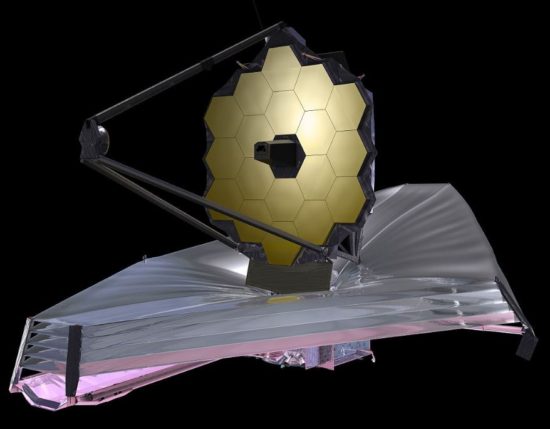
Civilization is in the very first stages of placing sensors into space which eventually will help astronomers to learn more. One — the James Webb space telescope — is scheduled to launch sometime during the 2020s. Its purpose? — to tear down the 400-million-light-years-after-the-Big-Bang limit of the Hubble telescope.
Humans are going to be able to look back to the beginning of time, at long last. Understanding the process that brought us here is going to expand dramatically. Until then, the Drake equation (see illustration at beginning of the essay) and other speculative tools remain not much more than intriguing diversions.
New sensors like the Webb telescope will upgrade human understanding and bring a new realism that promises to sweep away much of the science-fiction people drink to satiate their thirst for ultimate knowledge.
Most articles, television shows, and movies that purport to portray the universe are (to risk overstating it) kind-of scammy. They seduce a gullible and curious public, which is hungry for answers about the universe that no one yet has.
The science community has a vested interest in public funding; they tend to go-along with dubious depictions to pander popular support. Claims that astronomers today understand fully the nature of the universe are ludicrous. The universe is vast. Much of its matter and energy that scientists believe is “out there” can’t be found — not yet anyway.
Most stars are too faint to see with unaided eyes. The closest star system to our Sun, Proxima Centauri, is too faint to see without a telescope.
Three out of four stars in the galaxy are probably red dwarfs. Red dwarfs burn essentially forever but are smaller and much cooler than the Sun, which makes them impossible to observe without special infrared detectors.
These infrared detectors are launched into outer-space beyond Earth’s atmosphere to avoid being blinded by the infrared heat radiating off Earth’s surface.
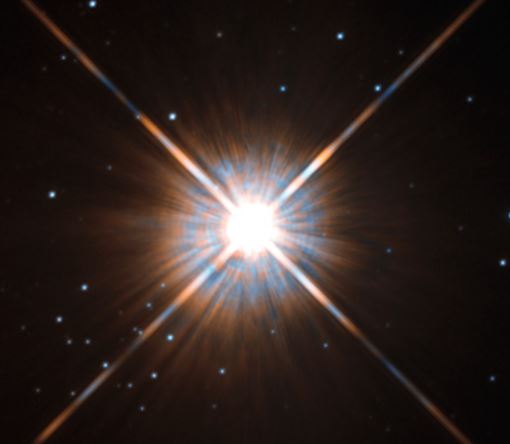
Red dwarfs seem to be emitting solar flares that are a thousand times more energetic and frequent than those generated by stars like the Sun. They emit light in frequencies not useful for plant photosynthesis — the basic life-support process on Earth.
It’s difficult to see how Earth-style life could get started and survive inside a red dwarf planetary system. No one knows what percentage, if any, of red dwarf stars have planets suitable for life.
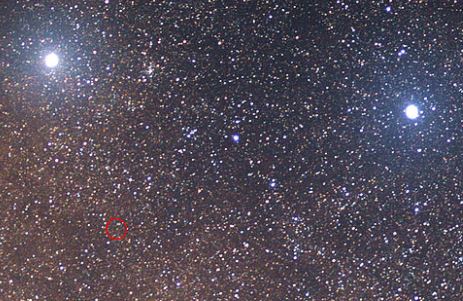
Red dwarfs live for thousands-of-billions of years. The Sun’s lifespan is eight to ten billion years — a tiny fraction of a red dwarf’s.
The Sun is similar to — who knows? — maybe one in five stars in the galaxy. It’s an optimistic guess, based on sampling and wishful hoping. Astronomers seem to agree that the Sun ranks as one of the largest stars in the Milky Way.
Statistical sampling of two-trillion galaxies argues that the Milky Way galaxy is also among the largest. A full 90% of all galaxies are smaller.
Calculations involving galaxy-motion and gravity suggest that when astronomers look at the cosmos, they aren’t seeing ninety-five percent of what’s out there. Physicists call the missing stuff dark energy and dark matter. Something that no one has yet been able to detect seems to be distorting the rotation of galaxies and disrupting the metrics of space-time.
The universe seems to be expanding, and the expansion is accelerating. Where is the missing mass and energy that drives the expansion? No one knows.
Perhaps parallel universes are stacked on every side against our own. They might swarm like bees around a hive. The gravitational pull of their enormous masses might be pulling our own universe apart. Galaxies inside our universe might be falling toward massive structures that lie outside our field of vision beyond a kind of event horizon.
Again, no one knows. It’s speculation. Today the expansion is described by a simple constant added into Einstein’s equation for General Relativity. A constant seems too simple, at least for me. It describes but doesn’t explain.

Many of the galaxies that are visible from Earth are tens-of-thousands of times farther away than the farthest stars in our own galaxy, the Milky Way, which astronomers say is at least 100,000 light years across — a distance of six-hundred-thousand trillion miles. The galaxy is perhaps 200 light years thick, but its center is thicker still — about 10,000 light years.
If the Milky Way was shrunk to the diameter of a ten-inch plate, the plate would assume a thickness of a few human hairs but at the center it would thicken to the size of an egg-yolk.
To put these distances into perspective, the latest space probes, which travel at roughly twelve miles-per-second, are not capable of escaping the gravity of our solar system until they are mechanically slung by multiple encounters with planets to a velocity greater than 27 miles per second. At that speed, crossing the Milky Way takes nearly 700 million years.
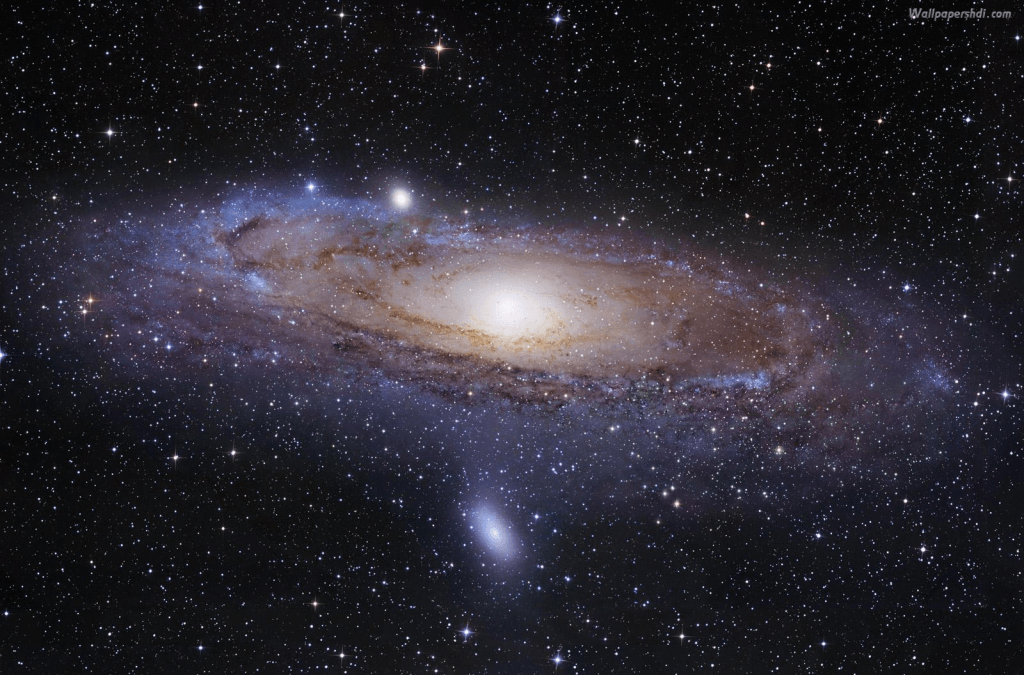
The Milky Way is one galaxy in what astronomers have learned is a universe of two trillion.
Until scientists know more — and it could be decades or even centuries from now — prudence and the scientific method advise odds-makers to use the most conservative estimates, not the most optimistic, to speculate about intelligent life in the cosmos.
Until evidence accumulates that is more compelling than what is available today, plugging conservative numbers into the Drake equation, or any other speculative tool, always seems to give the same discouraging result — a number so small it might as well be zero.
No intelligent life that can communicate across space should exist in our galaxy or anywhere else in the universe. None. Yet, here we all are. It’s kind of mysterious, at least to me.
Substituting less conservative numbers yields a different result. Intelligent civilizations could number in the thousands or even millions. No empirical evidence supports such optimism, at least not yet.

Looking closer to home within our own galaxy, astronomers in 2003 discovered Sedna, which some think is another dwarf-sized planet orbiting far beyond Pluto.
Astronomers seem to discover new planet candidates every other month — Eris and Makemake are two more Pluto-sized objects out of hundreds that come to mind.
In 2014 Caltech astronomers presented evidence for another planet they called the ninth planet, which might be an object ten times the mass of Earth orbiting in a highly elliptical orbit at the farthest reaches of the solar system.
Regardless of what astronomers continue to discover, it seems likely that the Sun will always contain at least 99% of the mass in the solar system.
Earth is fortunate to orbit a star that is located in a less active region of space than many other stars in the Milky Way. The Sun lies safely between two spiral arms that are bright because of ongoing birthing of new stars. The location lies halfway from the center of the galaxy to its outer edge.
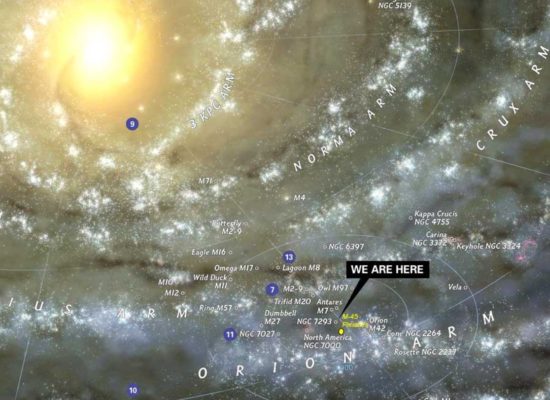
Although stars are spread more or less evenly throughout the Milky Way, life-destroying cosmic events are less likely in regions where stars aren’t being born. Earth lives between bright spirals in a zone of relative inactivity, which has enabled the evolution of eukaryotic one-celled life to progress to intelligence, then civilization, and finally to space exploration over the past billion-and-a-half years.
Earth has a number of unusual features that make it a good candidate for highly evolved life. One important feature is its nearly circular orbit around the Sun, which helps Earth avoid the catastrophic temperature variations characteristic of the more egg-shaped (elliptical) paths of some of the other planets, like Mars.
Only the orbits of Venus and Neptune are more round than Earth’s. Mar’s orbit is five times less round. Of all the solar objects, only Neptune’s moon Triton is known to have for all practical purposes a perfectly circular orbit.
Another advantage for Earth is its 300-mile thick atmosphere of nitrogen and oxygen, 80% of which lies within 10 miles of its surface. Nitrogen and oxygen make up 99% of Earth’s atmosphere. These gases are opaque to non-electrically-charged, high-frequency light.
Nitrogen molecules block high-frequency, ultra-violet light while oxygen molecules, slightly smaller, block higher-frequency (shorter wave-length) x-rays and gamma-rays, which can be lethal to living organisms.
A three-atom form of oxygen molecule known as ozone helps to absorb in the upper atmosphere a dangerous-to-life, lower-frequency-band of ultra-violet light that nitrogen can’t block.
In the distant past — during the Carboniferous Period 300 to 360 million years ago — Earth’s atmosphere held 60% more oxygen than it does now, which provided more shade against damaging high-energy light. Dinosaurs and large insects — like dragonflies with three-foot wing-spans — thrived in the highly-oxygenated air they breathed.
It is one of the wonderful ironies of our planet that the oxygen which empowers the biology of life also defends it against the physics of life-destroying high-energy light and cosmic rays that are always raining down from outer space.

In contrast to nitrogen and oxygen, which block high-frequency light from reaching Earth’s surface, carbon-dioxide, methane, and water vapor trap low-frequency light (infra-red light, or heat) and prevent it from radiating (or escaping) into space.
These green-house gases work like a blanket to help keep Earth at a constant temperature. Carbon dioxide, though rare, is heavy compared to oxygen and nitrogen. It tends to cling close to Earth’s surface where it is respirated by plants. Without atmospheric moisture, methane, and carbon dioxide the temperature of Earth would average 100°F below zero and vary widely between day and night as it does on the Moon.
Although water vapor and carbon dioxide make but a tiny fraction of the atmosphere, they have a significant impact on the planet’s ability to retain heat when their concentrations increase in the atmosphere. Exhaust from commercial jet aircraft, believe it or not, contributes greatly to the concentration of carbon dioxide and water vapor in the eight-mile highs of the atmosphere where these jets fly.
After the terrorist attack on 911, the government suspended all flights over the United States — including those by commercial aircraft — for four days. The skies over America cleared themselves of clouds and turned deep blue. Temperatures dropped.
I was amazed to observe these changes develop so quickly after all flying was suspended. It took about two weeks for aviation to return to pre-attack intensity. With the return of aviation, familiar weather patterns followed.
Unlike Earth, the planet Venus has so much carbon dioxide that its surface broils with heat. An explorer would have to hover thirty-seven miles above its surface to experience atmospheric pressures and temperatures similar to those on Earth.
By contrast, the atmosphere of Mars, though almost entirely carbon dioxide, is thin — only 1% as thick as Earth’s. Even so, near their surfaces the density of carbon dioxide is 15 times higher on Mars than on Earth — enough to grow plants and — if poisons in the soil can be avoided — terraform the surface should humans decide.
Although Mars is cold, especially at night, its carbon dioxide atmosphere enables daytime temperatures to sometimes reach 85° F during summer in its southern latitudes. The problem is that any plants that might grow in Martian soil must endure bombardment by dangerous-to-life high-frequency light and cosmic particles. Also, Martian soils are poisoned by perchlorates. The soil is useless for agriculture though perchlorates could be broken down to provide a source of oxygen.
I should mention argon, which is 1% of Earth’s atmosphere. It is formed by the radioactive decay of a rare isotope of potassium in Earth’s crust. It is transparent to infra-red heat, so it has no effect on global warming. It is heavy — like carbon dioxide — so it clings to the surface, but its small atoms, widely spaced, do little to prevent the escape of infra-red radiation.
Another asset that gives Earth an advantage for life is its large moon whose gravitational field acts like a vacuum cleaner to suck up cosmic-debris like asteroids and comets that might threaten to strike. Only Jupiter, Saturn and Neptune are similarly equipped.
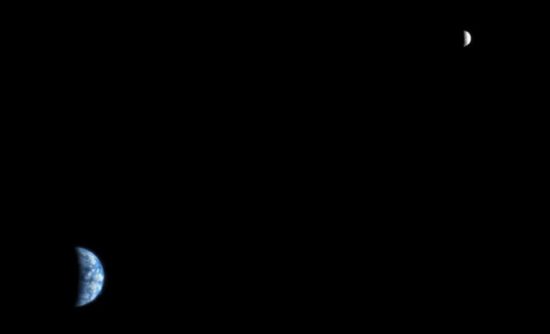
The moon stabilizes Earth’s tilt as it orbits the sun. The tilt is about 23.4°, which is why Earth has seasons. The tilt swings back and forth a few degrees over periods of 41,000 years. This variation is stable enough to permit life to survive and evolve despite the periodic generation of ice-ages.
Computer simulations of a moonless Earth show that with no moon to stabilize it, tilt variations could approach 90°. Dramatic destabilization has emerged in some simulations that make it difficult to imagine how advanced life could evolve and survive the climate extremes that might result from chaotic wobbling.
The Moon is receding away from Earth at a rate of almost two inches per year. It will take at least a billion years for the motion of Earth to destabilize. It seems that humans have time to figure something out.
Sadly, the sun gets brighter and less massive with each passing day. Over the course of a billion years, Earth will move farther from the sun to conserve its angular momentum. Meanwhile, the warming sun will overtake Earth’s great escape to evaporate its oceans and make the planet uninhabitable.
Looking at coming events from a more optimistic perspective, people can probably agree that a billion years is a long time. The species-human is likely to be extinct by then anyhow. So why worry?!
Another life-enhancing feature of Earth is its large, open, ice-free, salt-water oceans. Most scientists believe salt-water oceans provide safe habitat for evolving life.
Earth’s oceans make up three-fourths of the planet’s surface. In addition to providing a vast incubator for life, oceans reduce the probability that space-debris will fall onto land.
Odds are that debris will fall into the oceans where it is rapidly cooled and rendered harmless. Should debris strike land and throw up clouds of dust and ash to block the sun, the oceans provide a safety-blanket of thermal protection.

Besides Earth, only Titan — one of Saturn’s many moons — has open oceans (of liquid methane and ethane) on its surface. These oceans are more like shallow seas or lakes, estimated to be about five-hundred feet deep. Scientists think Titan has a salty sub-surface water ocean, as well.
NASA reported this year that another moon of Saturn, tiny Enceladus (310 miles in diameter), holds a six mile deep subsurface ocean — confirmed from Cassini fly-bys. Its over one-hundred geysers are what is populating Saturn’s E-ring. Data from the geysers indicate that the ocean is warm and salty and saturated with organic molecules. Analysis by Cassini instruments is on-going.
Of the moons of Jupiter, only Europa, Ganymede, and Calisto are thought to harbor salt-water oceans.
Europa is known to have a salt-water ocean, but it is covered by miles-thick ice.
Ganymede, the largest moon in the solar system, is believed to have a 500 mile deep salt-water ocean that lies beneath a crust 125 miles thick. The crust is thought to be a rock and ice mixture.
Scientists suspect that Callisto has a salt-water ocean, but it might be sandwiched between ice layers sixty or more miles beneath its surface.
Only the oceans of Earth are open, un-frozen, and deep enough (averaging three miles) to protect Earth against most encounters with meteors and other space-debris.
Fortunately for Earth, the solar system itself contains a massive structure that helps to protect and shield it from danger. It is Jupiter, the large and strongly gravitational planet, which like the moon pulls away space-debris that might otherwise zoom toward Earth to imperil all life. Observations suggest that comets strike Jupiter every couple of years. Comets that don’t strike are gravitationally deflected out of the solar system more often than not.
Another fortunate feature: Earth has, geologists say, a molten iron-core that emits a strong magnetic field to deflect life-destroying, electrically-charged cosmic particles, that have energies, some of them, approaching those of baseballs traveling sixty miles-per-hour. Cosmic particles accelerated the process of ripping away Mar’s atmosphere. Without a magnetic field the Mars atmosphere is defenseless against cosmic erosion.
As for Earth, high energy particles that do manage to blast through it’s magnetic shield (magnetosphere) are often scattered and rendered harmless — fortunately — by collisions with the oxygen molecules in Earth’s dense atmosphere.
One exception is muons, which are byproducts of particle collisions high in Earth’s atmosphere that are energetic enough to burrow down to hundreds of yards beneath Earth’s land surfaces and oceans. In rare heavy bombardments at high altitudes, muons can increase risks of cancer and cataracts to pilots and their passengers. Muons are like electrons except that they are 207 times heavier and much shorter-lived.
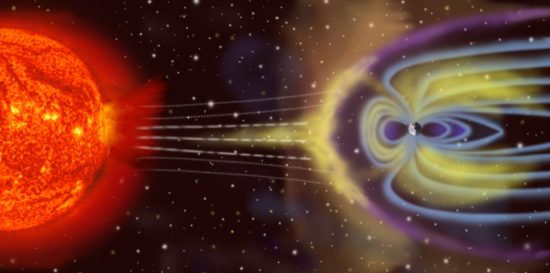
The magnetosphere is strong enough to deflect the solar wind, which can strip away all or part of the atmosphere of any planet that lacks one (like Mars).
The magnetosphere is effective and strong, because it is huge and surrounds Earth out to five Earth-diameters on the side facing the sun; one-hundred Earth-diameters on the side opposite. In any small area of space, though, a simple bar-magnet is fifty times stronger.
The solar wind isn’t all bad. As it radiates outward from our Sun, it forms a huge magnetic bubble called the heliosphere that extends 3.5 billion miles past the Kuiper Belt.
Inside this Sun Bubble the rest of the solar system is protected from massive cosmic particles that pour in from the two trillion galaxies of stars that make the universe. The Sun bubble deflects to shade our solar system in relative safety.
The heliosphere of the Sun works together with the magnetosphere of Earth and its oxygenated atmosphere to break up and knock away the vast majority of cosmic particles (high-speed protons and atomic nuclei) that would otherwise rip Earth-life to shreds.
Absent the magnetosphere, life could evolve safely only in the deep oceans or far below the surface of Earth. Stated differently: a strong, protective magnetic field is essential for the survival of surface life on any planet.
Large solar flares are known to have enough energy to kill exposed astronauts. It’s one of many reasons NASA doesn’t send people to Mars, which lacks a magnetosphere. Mars is under relentless bombardment of atomic particles that can damage the atoms and molecules in the cells of a human body.
All planets have magnetic fields of various strengths except Venus and Mars. The iron in the core of Mars is believed to have frozen solid, or nearly so, hundreds of millions of years ago, which helped force its protective magnetic field to collapse.
Venus retains its molten iron-nickel core, but the planet lacks tectonic action in its crust. The heat of its core can’t escape through its surface, which prevents in its molten center the emergence of the turbulence essential to make a planetary dynamo of sufficient power to rev-up a magnetosphere.
It’s a shame that both Mars and Venus lack magnetospheres, because both planets have attributes that might otherwise make them good candidates for life.
Earth’s core is huge — it rivals the entire planet of Mars in size. The inner third of the core — the center — is already frozen solid. It is believed to be pure iron. The core is freezing itself solid from the inside out.
The rest of the core is hot liquid iron and nickle, mostly, with some sulfur and other impurities mixed in. It circulates in complex eddies, which generate the magnetic fields that protect Earth by deflecting the solar wind.
The flow of currents in the molten metal is made stable and more reliable by the unusual plate tectonics peculiar to Earth. Gaps in Earth’s crustal plates allow heat to escape from volcanic valves, which help to maintain a controlled roil in the eddy currents to produce the dynamo that drives its magnetosphere.
The only moon known to have a magnetic field is Jupiter’s Ganymede. Jupiter itself harbors a field fourteen times more powerful than Earth’s. The giant planet’s four largest moons orbit inside it, where they are protected from the solar-wind and low frequency (low-energy) cosmic particles. By contrast, Mercury’s magnetic field is one-hundred times less powerful than Earth’s.

Despite these several advantages for sustained evolution of life, Earth has the apparent disadvantage of a volatile climate which, scientists believe, has turned cold and icy during several extended periods. I mention this volatility to remind people that the circumstances that have enabled life to advance to the technological civilization of today are complex and not obvious.
Until scientists are able to tease out of history what is actually important and significant for the development of advanced life, no one can know what the rest of the universe may have in store — unless we travel out into space and explore it.

Here’s the problem. The closest stars to the Sun are twenty-five trillion miles away. To escape the solar system, engineers must build spacecraft that can accelerate to 27 miles per second. At that speed the nearest stars, Proxima Centauri, and the binary star system, Alpha Centauri, are 30,000 years distant.
How are humans going to explore the universe? How are we going to answer the questions about our place in the cosmos, when we can’t travel to the nearest stars?
There are trillions of stars, most of them many millions of times farther away than these, our closest neighbors. It seems hopeless that anyone will ever know the answers to the basic questions about the universe that so many are asking.
Still, in my heart of hearts, I want to believe we will find a way.
Billy Lee
Editors Note: November 2017; NASA announced that the latest count of galaxies might be as high as two trillion. The velocity required by spacecraft to escape the Milky Way galaxy from Earth (our planet is 25,000 light years from the galaxy center) is 342 miles-per-second. At this velocity the nearest galaxy — Andromeda — is a flight of 2.28 billion years. There are two-trillion galaxies more!
It doesn’t really matter. Here’s why:
The Parker Solar Probe scheduled for launch in 2018 will require seven gravity-assists from Venus over a period of six years to reach a velocity of 120 miles-per-second before it embarks on a 2024 suicide mission into the outer atmosphere of the Sun.
Venus and the Sun combined can’t accelerate the Parker Solar Probe to the galaxy-escape velocity of 342 miles-per-second.
Minus gravity-assists, the fastest vehicles in development today by space-flight engineers will accelerate to speeds less than 27 miles-per-second — the escape velocity required to exit the solar-system. Without gravity assists that take years to rev-up, we humans can’t leave our own solar system, which is arguably the tiniest imaginable fraction of the Milky Way galaxy.
The good news is that life-forms in far-away solar systems face the same obstacles. If they are hostile, humans can be assured that they will have a difficult time getting here.
The bad news is that humans are trapped. The Milky Way Galaxy is a prison. We can’t escape, at least not yet; most likely, not ever. The escape velocity of the Milky Way Galaxy from Earth exceeds 340 miles-per-second — nearly three times the velocity that the Parker Solar Probe will be traveling when it is finally able to bury itself inside the Sun.



